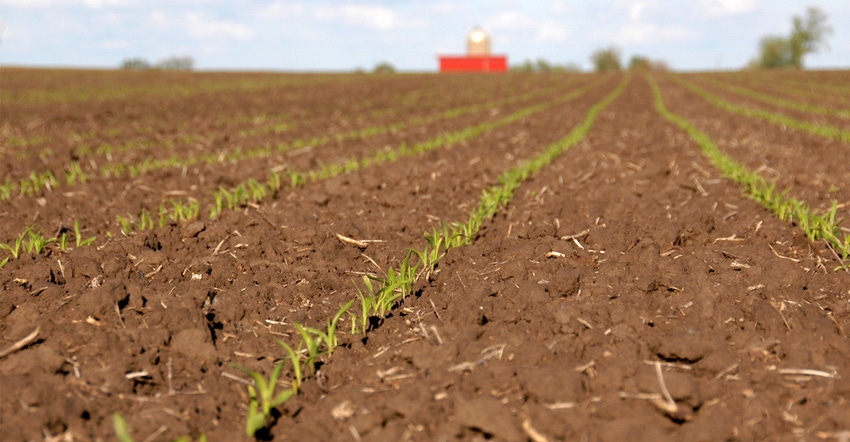
Are you ready for another planting season? A successful harvest starts the day seed goes in the ground, notes Bryce Baker, Precision Planting. “The planter pass is the most important pass of the year,” he explains.
The significant seed corn investment farmers make each year comes with hefty expectations. “When we take seed and put it in the planter, we have one goal in mind,” says Doug Wiegand, region manager. “We want a harvestable ear off every seed we put in the ground.” A lost ear per 1/1000 of an acre shaves off 7 bushels an acre, he adds.
What’s the secret to harvestable ears? Consistent emergence.
Late-emerging plants that are one leaf collar behind neighboring plants will only develop to half their potential. Late-emerging plants that are two collars behind won’t produce at all, Wiegand notes.
How do you achieve even emergence? Here’s what Wiegand and Baker have to say:
1. Manage residue. Residue in the furrow can take moisture and nutrients away from seeds, Baker says, causing seeds to germinate and emerge later than other seeds in the row. Excess residue traps moisture and causes fluctuations in available moisture as the planter moves down each row. Seeds planted in the right spot within the moisture line will germinate, while seeds in drier areas may not germinate as quickly, or at all.
Last, Baker explains that toxins left behind from microbial activity in the residue could cause seedling blight. Seedling blight may stunt growth or cause total loss of the plant.
Row cleaners that clear residue, without making dramatic shifts to the soil, are an effective way to manage fields with heavy residue.
2. Close the trench. “I’ve walked a lot of fields in several states, and the biggest weakness related to emergence was closing the trench,” Wiegand says. The only way to check if trenches are closed from the bottom up is to stop the tractor and manually check the row. If your trench looks more like a “W” than a “V,” Wiegand says it’s time to check your disk openers. New disk openers generally run 14, 15 or 16 inches in diameter, and need to be replaced after a half inch of wear on the diameter or a quarter inch on the radius.
To create a true “V,” Wiegand advises 1.5 to 2.5 inches of contact on a 3-millimeter disk, or 1 inch of contact on a 3.5-mm disk. “Once you get your contact point, spin it and make sure it never gets less than 1 inch — you don’t want a gap,” Wiegand says. “Too much contact puts a lot of side stress and torque on the bearings.”
If you run a Case IH planter, he says they have a unique offset disk design and require an eighth-inch gap.
3. Even up your planter. Taking a quick panoramic look at your planter could save you a lot of trouble, Wiegand says. A planter running nose-down in a no-till field will result in a coulter running deeper than the disk opener, creating a false bottom and lessening the closing wheel pressure that impacts emergence. Wiegand adds the toolbar should be low enough that the parallel arms are level to the ground across the planter.
4. Check seed depth. Plant seeds too shallow, and they won’t have adequate moisture. Soils may be too cold for seed planted too deep, Baker notes. Check rows early and often to ensure seeds are going below the moisture line. He adds the new SmartFirmer from Precision Planting will track moisture levels in the row as you plant and signal changes in soils, without you manually checking depth.
5. Apply the right downforce. Applying too much or not enough downforce can have a negative impact on yield, Baker notes. The “sweet spot” is enough weight to maintain planting depth, but not more than 200 pounds of actual gauge wheel weight, which could create sidewall compaction complications. Downforce can be adjusted manually after physically inspecting planted rows or automatically adjusted with tools like the DeltaForce by-the-row hydraulic downforce system. Baker adds that Beck’s Practical Farm Research showed an average yield increase of 9.4 bushels per acre with automated systems like DeltaForce compared to manual settings.
6. Establish ideal singulation. A skip here, a double there — does it matter if you hit your population goal? Baker says farmers lose more than 2 bushels per acre for every 1% singulation error for skips. Doubles had less of an impact, at just under 1 bushel per acre for the same error. Wiegand advises taking seed meters to a dealer yearly for a performance check prior to planting.
“Everything has to be dialed in,” he says. “We’re looking for performance, not endurance.”
About the Author(s)
You May Also Like




